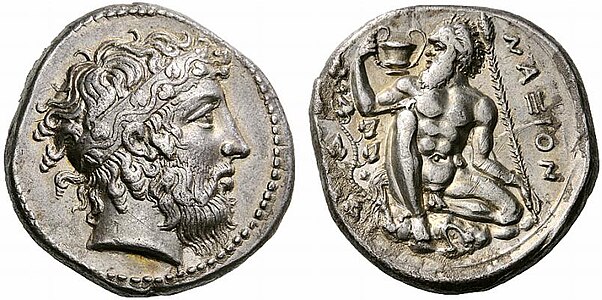Naxos (Sicily)
Νάξος | |
 Walls of Naxos | |
| Location | Giardini Naxos, Province of Messina, Sicily, Italy |
|---|---|
| Coordinates | 37°49′23″N 15°16′24″E / 37.82306°N 15.27333°E |
| Type | Settlement |
| History | |
| Builder | Chalcidean colonists |
| Founded | 734 BC |
| Periods | Archaic Greece to Classical Greece |

Naxos or Naxus (Greek: Νάξος) was an ancient Greek city of Magna Graecia, presently situated in modern Giardini Naxos near Taormina on the east coast of Sicily.
Much of the site has never been built on and parts have been excavated in recent years.
Its remains are open to the public and an on-site museum contains many finds.
Location
The city occupied a low rocky headland, now called Cape Schisò, formed by an ancient lava flow, immediately to the north of the Acesines (modern Alcantara) stream.
Name

There can be little doubt that the name was derived[1] from the origin of the first colonists from Naxos in Greece.[2] This has become even more definite since 1977 when the marble cippus (or sacred stone) inscribed with a dedication to the goddess Enyo was found in the large sanctuary west of the Santa Venera river. The characters are written in the unique 7th c. BC script of Greek Naxos.[3]
History
Foundation
Ancient writers agree that Naxos was the most ancient of all the Greek colonies in Sicily;
The new colony must have been speedily joined by fresh settlers from Greece, as within six years after its first establishment the Chalcidians at Naxos were able to send out a fresh colony, which founded the city of Leontini (modern
5th century BC
The 5th century BC was very turbulent for the city as confirmed by the archaeological record. It was one of the cities besieged and taken by
The name of Naxos is not specifically mentioned during the revolutions that ensued in Sicily after the death of Hieron; but there seems no doubt that the city was restored to the old Chalcidic citizens at the same time as these were reinstated at Catana, 461 BC;
For the great Athenian expedition to Sicily (415 BC), the Naxians immediately announced their alliance, even though their related cities of Rhegium (modern
Tauromenium
The
Roman
Some late Roman construction over the Greek ruins includes a mansio and streets found on the bedrock continuing the general line of the ancient stenopos.[29]
The site

The city walls are visible on the south of the site and were built in the mid 6th c. BC using the Cyclopean polygonal technique. They were up to 8 m high with the first 2 m of stone and the higher layer of mud bricks.
The city was completely rebuilt in about 470 BC probably by Hieron I of Syracuse with a new

The seafront façade of the shipyard complex indicates that the present sandy beachfront is circa 180–190 m further out from the 5th century BC the coastline and that the sea level was about 2 m higher than at present.
Coinage
The coins of Naxos, which are of fine workmanship, may almost all be referred to the period from 460 BC to 403 BC, which was probably the most flourishing in the history of the city.
-
Tetradrachm minted in Naxos from the 5th century BC.[31]
-
Greek Silver Tetradrachm of Naxos (Sicily)
See also
References
- ^ a b Hellanicus FGrH 4 F82
- ^ Apud Stephanus of Byzantium s. v. Χαλκίς
- ^ Panhellenes at Methone: Jenny Strauss Clay, Irad Malkin, Yannis Z. Tzifopoulos, Walter de Gruyter GmbH & Co, p 168
- ^ Hellanicus FGrH4 F82
- ^ Thucydides VI.3.1.
- ^ Thucydides vi.3; Ephor. apud Strabo vi. p. 267; Scymn. Ch. 270-77; Diodorus Siculus xiv.88. Concerning the date of its foundation see Clinton, F. H. vol. i. p. 164; Eusebius Chron. ad 01. 11. 1.
- ^ Thucydides vi.3; Appian, B.C. v. 109.
- ^ Thucydides vi.3; Scymn. Ch. 283-86; Strabo vi. p. 268.
- ^ Strabo vi. p. 268; Scymn. Ch. 286; Thucydides vi. 4.
- ^ Strabo vi. p. 272; Scymn. Ch. 286
- ^ Lentini, M. C., & Whitbread, I. K. (2012). RECENT INVESTIGATION OF THE EARLY SETTLEMENT LEVELS AT SICILIAN NAXOS. Mediterranean Archaeology, 25, 309–315. http://www.jstor.org/stable/24653576
- ^ Herodotus vii.154
- ^ Diodorus xi.49
- ^ M. Lentini, Naxos of Sicily in the 5th century BC: New Research, GREEK COLONISATION New Data, Current Approaches, Proceedings of the Scientific Meeting held in Thessaloniki (6 February 2015)
- ^ Diodorus xi.76
- ^ Diodorus xiii.56, xiv.14; Thucydides iii.86, iv.25
- ^ Thucydides iii.86
- ^ Thucydides iv.25
- ^ Diodorus xiii.4; Thucydides vi. 50
- ^ Thucydides vii. 57
- ^ Diodorus xiii.56
- ^ Diodorus xiv.14, 15, 66, 68
- ^ Diodoros xiv.58, 59
- ^ Diodorus xiv.88
- ^ Diodoros xiv. 87
- ^ Diodorus xvi.7
- ^ Pliny, N.H. iii. 8. s. 14
- ^ Appian, B.C. v. 109
- ^ Pelagatti P., ‘Nasso: storia della ricerca archeologica’, Bibliografia Topografica della Colonizzazione, Greca in Italia, xii (Pisa and Rome),1993, 268–312
- ^ Pelagatti 1976-1977: P. Pelagatti, “L’attività del- la Soprintendenza alle Antichità della Sicilia Orientale”, Kokalos 22-23, 519-550.
- ^ ISBN 0 900652 46 2
 This article incorporates text from a publication now in the public domain: Smith, William, ed. (1854–1857). "Naxos". Dictionary of Greek and Roman Geography. London: John Murray.
This article incorporates text from a publication now in the public domain: Smith, William, ed. (1854–1857). "Naxos". Dictionary of Greek and Roman Geography. London: John Murray.



![Tetradrachm minted in Naxos from the 5th century BC.[31]](http://upload.wikimedia.org/wikipedia/commons/thumb/a/a2/Dionysos_tetradrachm_Naxos.JPG/611px-Dionysos_tetradrachm_Naxos.JPG)
![Drachm minted in Naxos from the 6th century BC.[31]](http://upload.wikimedia.org/wikipedia/commons/thumb/8/8a/Naxos-02.jpg/619px-Naxos-02.jpg)


